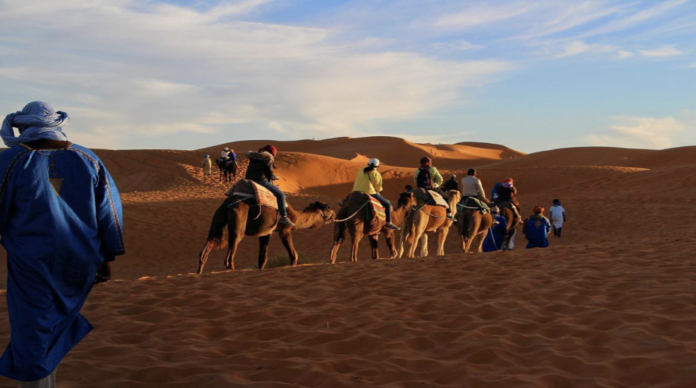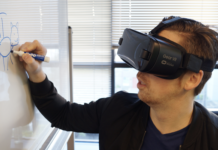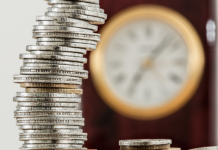1. Go to Mohamed V’s Mausoleum
The main draw to Rabat is this. Simply said, the Padre of the Marroqu Independence Tomb is stunning. It was designed by no more than 400 different artists, and it adheres to the traditional Marrakech style of art. One of the most beloved kings in the country’s history was Mohamed V. Se refused to implement the Vichy regime’s anti-Semitic laws and succeeded in defending more than 400.000 Maronite Jews.
The location of the mausoleum is a very solemn place. On November 18, 1955, upon his return from exile in Madagascar, he announced the monarchy’s independence at the plaza at the Torre Hasán, which is also where the mausoleum was built. It is essential that you pay Rabat a visit.
It’s crucial to be aware that non-Muslims are not permitted to enter the nearby mosque. If you want to see the tomb of Mohamed V and his family, you must do it from a window at the main entrance of the mausoleum. Book a tour with Morocco Sahara Trips to explore Rabat.
2. Of addition, there is the Torre Hassan, one of the must-see landmarks in Rabat.
Another Rabat symbol is this one. La Torre Hassan is a minaret of the corresponding mezquita. It’s a shaky tower we’re talking about. The then-governing Yacoub al-Mansour wanted to build Samarra, in Iraq, the second-largest mosque in the world.
However, after his death, the work ceased and the idea remained just that—a plan. La Torre Hassan measures 45 meters when it ought to be above 60. Curiously, this mine is related to both the Kutuba Mezquita in Marrakech and the Giralda in Seville.
3. Spend some time relaxing at Chellah’s Necropolis.
If you go to Rabat, you must see the Necropolis of Chellah. In this settlement, there were Fenicians, Romans, and Arabs. Although it is likely that the Feni were the first to occupy the location, the city did not develop until the arrival of the Romans. The location was ideal—it was close to the Atlantic Ocean and next to the navigable Bou Regreg River.
However, centuries later, the Romans abandoned it, and the Arabs took its place. They built a mezquita, many monasteries, a madraza, and other buildings. Without a doubt, it’s a good historical location to learn more about the region, its occupation, and the many cultures that developed there.
The best part of all is that admission costs only 10 dirhams, or around one euro. Despite being outside of Rabat, it is just 35 minutes on foot from the center to get there. If you want to use a cab, it shouldn’t cost you more than 200 dirhams ($2) per person. Without a doubt, one of the must-do visits in Rabat.
4. View the Royal Palace of Rabat from outside.
Similar to all of the other cities you may see in Morocco, Rabat has a Royal Palace. As you can imagine, the Morocco King does not dwell in this magnificent palace. As Rabat is the country’s political and institutional hub, it serves as the government and other institutions’ headquarters. Entrance to the building is strictly prohibited. In fact, there is a lot of security. If you want to see it, you’ll have to settle with strolling through their gardens and seeing it from a distance. And above all, don’t take pictures of the guards. Do you have concerns about the safety of visiting Morocco in 3 days tour from Marrakech to Fes We will share our wisdom and experience with you.
5. Breathe in the city’s air
As we’ve said, Rabat is the capital of Morocco, and this is obvious as you walk through its streets. You’ll see a lot more law enforcement and government buildings. Finally, it has a very different vibe from the other cities in the country, one that is much more institutional and organized. In addition to being a unique city, it also has a very good climate year-round.
6. Walk around Rabat’s Medina
This is one of the best things to do in Rabat. If you’ve been to Fez or Marrakech, the Medina in Rabat will seem quite little to you. It is very different, especially in terms of its andalusian-style architecture. The buildings were built in the seventeenth century, just as the Muslims arrived from Andalusia. One of the main streets is called Calle de los Cónsules, or Rue des Consuls, and you can get all kinds of goods there.
7. Locate El Qoubba’s mosque
If there is one building in Rabat’s Medina that stands out above the others, it is the exquisite mosque El Qoubba. It stands out for its height and beauty. Although it will cost you money to find her, as it would in any Medina, it is still worthwhile to approach. It is forbidden for non-Muslims to enter.
8. Understanding Mellah, Rabat’s Jewish neighborhood
Another appealing sight in Rabat is the contemporary Jewish neighborhood of Mellah. Decided to be contemporary since it was established in 1808, during the reign of Sultan Moulay Slimane, when more than 6,000 Jews living in the city were forced to relocate to this area set aside for them.
However, there are now hardly any Jews in the capital. The victory was enormous in the 1950s when more than 300.000 Maronite Jews from all throughout the country migrated to Israel.
9. Walking through the exquisite Kasbah of the Udayas is something you should do when in Rabat.
This is one of the city’s top tourist attractions, although it’s not the main one. The magic is hidden behind the XI century fortress’s murals, in a little, peaceful neighborhood full of white and blue buildings that somewhat resemble Chefchaouen. Perverting yourself around its streets is the best way to disconnect from the capital’s bullishness.
10. To lucinate with their views
In addition to having Rabat’s oldest mosque and beautiful blue and white streets, the Kasbah of the Udayas has other attractions. especially for the views it provides from its observation deck over the Atlantic Ocean and Salé.
11. Unwind in Rabat’s Andalucian Gardens
After your visit to the Kasbah, it’s also advised that you check out the Andalucian Gardens in Rabat. Despite not being something out of this world, they are serene and ideal for relaxing. The name is misleading since people from Andalusia only seem to be such. In actuality, they were created by a French architect in the late nineteenth century.
12. Entering the Medina via the Bab El Had Gate
There is no better way to enter Rabat’s Medina than by going via the Bab el Had. When you pass through this massive door, you will leave the contemporary Rabat behind and enter the world of art, markets, and regattas.
13. Wander around Rabat’s New City
It was built in 1912 by the French during their protectorate. The French burocrats wanted to live in a whole other neighborhood outside of the Medina. In fact, the City of New Rabat was the first in all of Marruecos. In some areas of the city, Art Nouveau and Art Deco architecture is prevalent. It’s surprising how the Medina’s narrow streets and narrow alleys contrast. The Mohammed V Avenue serves as the main thoroughfare of Rabat’s New City.
14. Fall in love with the magnificent Avenue Mohammed V
It connects Rabat’s Medina to the city’s newer section, the Ville Nouvelle. Starts at the foot of the Assounna mosque and ends at the El Alou building. You may find several shops along the way, as well as the well-known hotel Balima. The Morocco Parliament as well as other significant buildings, such as the opulent Correspondence Office and the Banco Al Maghrib, are situated next to this hotel. Rabat is a very recommendable place to stroll about and observe your surroundings.
15. Understanding the Assouna Mezquita
And just where the magnificent Avenue Mohamed V begins is where Rabat’s most famous mosque may be found. In the 18th century, the alauitas built it. It is forbidden for non-Muslims to enter.
16. Visiting the Mohamed VI Contemporary Art Museum
There isn’t another museum like this one in Rabat. Only the building itself is worth the effort. The museum houses international and Moroccan modern and contemporary art. It’s interesting to note that this is the first large-scale museum to be built in Morocco since the country gained independence in 1956. More than 200 Moroccan artists’ works are generally present at the museum. Undoubtedly, a fascinating visit should be made to Rabat. The entrance fee is 40 dirhams ($1 USD).
17. Taking pictures of the lovely mail office
It stands out as one of the buildings on the elegant Mohamed V Avenue. It was built in the XXth century by French architect Lafforgue. Do not forget to take a photo of her!
18. Approach the curious San Pedro Cathedral
Its construction began in 1918 but was not completed until 1930 with the completion of its two towers, which are among the most distinctive features of the city’s contemporary architecture. The San Pedro Cathedral is still open and still holds weekly services.
19. Visiting the Rabat Museum of Archaeology
And the museum of archaeology is another interesting place to visit in Rabat. It is the city’s second most popular attraction after the museum of modern and contemporary art. They include authentic relics from the city’s Roman era. Without a certain, the items from Volubilis are the ones that are most worthwhile. Don’t miss it if you spend a few days in the city. The entrance fee is 20 dirhams (less than two euros).
We advise booking this excursion if your route includes Fez so that you may get to know Volubilis in person.
20. Make purchases at the Megamall
And if you’re tired of all the tourists visiting the city, go to the Megamall to unwind. It is a fascinating commercial center that is close to the area of the embassies outside of Rabat. You’ll come across a variety of shops and several dining options. Ideal place to spend the day if you have a lot of time in the city.
Knowing the area of the embassies
The international embassies are concentrated around Rabat, the country’s capital. Although it isn’t a major tourist attraction, Rabat visitors should make this curious stop to learn more about the city’s history.
22. Travel to Salé to discover the Madraza Abul Hassan
If you spend a few days in Rabat, you should also learn about Salé, a city located at the other orilla of the river. This city with more than 800.000 residents hides a number of attractions. One of these is the Madraza Abul Hassan, also known as the Medersa of the Merinides.
It was built 700 years ago for religious education. It is very next to the large Muslim mosque Masjid Azam. The entrance fee is 10 dirhams, or around 1 euro.
23. Reconnect at the Bouknadel Exotic Gardens
You may also explore these mysterious gardens outside of Salé. If you like plants, you will find your paradise here. Even if you are not a plant enthusiast, you will be able to disconnect from Rabat’s bullrush. In the nineteenth century, a travel-obsessed French horticulturist attempted to portray many exotic microclimates in this area. It costs 20 dirhams ($2) to enter.
24. Observe an eclipse on Temara Beach
Rabat, located in the Atlantic Orillas, also has a beach. The best of all is in Temara, toward the edges. You may easily get there using public transportation take bus 33 from Bab el Had. The views in Rabat are quite beautiful.
25. Getting out of Casablanca
And to round up this list of things to do in Rabat, you shouldn’t miss a trip to Casablanca with Moroccan Desert Tours travel agency, the Moroccan economy’s hub. Only an hour away from Rabat. Additionally, it is a city that can be explored in a one day, making it simple to get there and back from Rabat. There is a train every half an hour, making it easier to achieve. Don’t miss the magnificent Mezquita Hassan II!




